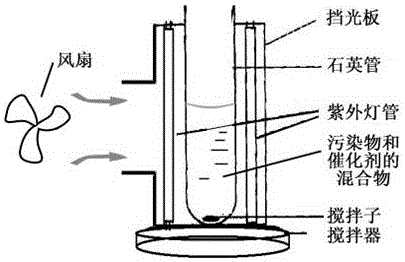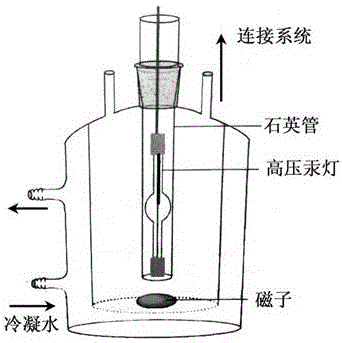Strontium antimonate photocatalyst and preparation and application thereof
A catalyst, strontium phototechnology, applied in the field of environmental pollution control, can solve the problems of low efficiency of photocatalysis technology, achieve high quantum efficiency, high activity stability, and significant economic benefits
- Summary
- Abstract
- Description
- Claims
- Application Information
AI Technical Summary
Problems solved by technology
Method used
Image
Examples
Embodiment 1
[0030] A preparation method of strontium antimonate photocatalyst, comprising the following steps:
[0031] Dissolve potassium pyroantimonate in boiling water to prepare a solution, named solution A, and its concentration is 0.1 mol L -1 ; Dissolve strontium chloride in deionized water to form a solution, named solution B, with a concentration of 0.125 mol L -1 ; Take 25 mL of solution A, and slowly drop it into 10 mL of solution B; after the dropwise addition, add 35 mL of water to dilute; stir the suspension at room temperature for 12 hours, adjust the pH value of the solution to 8; The solution was transferred into a 100 mL reactor and heated at 180°C for 8 hours to fully crystallize the sample; the cooled sample was centrifugally washed and dried at 80°C; the dried sample was pressed into tablets and sieved with 50-70 mesh to obtain Strontium antimonate photocatalyst, the specific surface area of the photocatalyst is 50-250 m 2 / g, the grain size is 2-56 nm.
[0032] ...
PUM
| Property | Measurement | Unit |
|---|---|---|
| wavelength | aaaaa | aaaaa |
| specific surface area | aaaaa | aaaaa |
Abstract
Description
Claims
Application Information
 Login to View More
Login to View More - R&D
- Intellectual Property
- Life Sciences
- Materials
- Tech Scout
- Unparalleled Data Quality
- Higher Quality Content
- 60% Fewer Hallucinations
Browse by: Latest US Patents, China's latest patents, Technical Efficacy Thesaurus, Application Domain, Technology Topic, Popular Technical Reports.
© 2025 PatSnap. All rights reserved.Legal|Privacy policy|Modern Slavery Act Transparency Statement|Sitemap|About US| Contact US: help@patsnap.com



